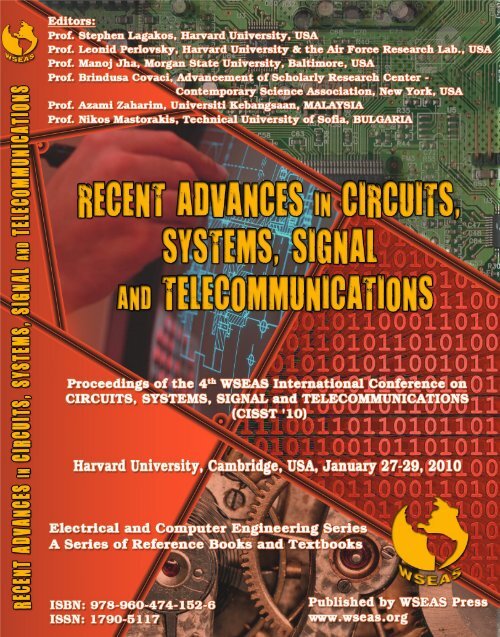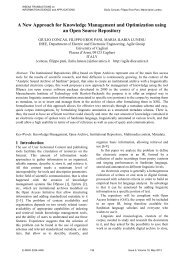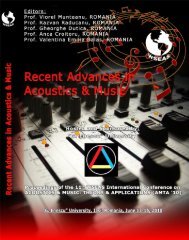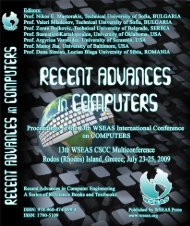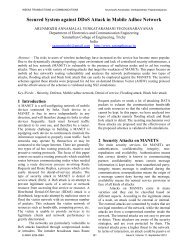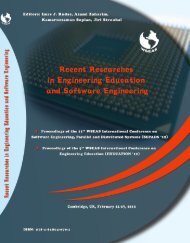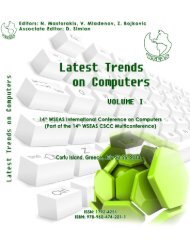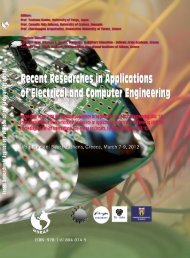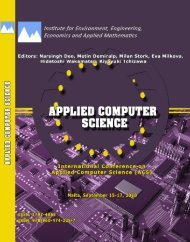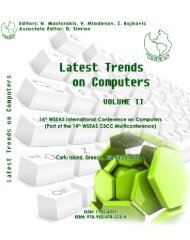RECENT ADVANCES in CIRCUITS, SYSTEMS, SIGNAL ... - Wseas.us
RECENT ADVANCES in CIRCUITS, SYSTEMS, SIGNAL ... - Wseas.us
RECENT ADVANCES in CIRCUITS, SYSTEMS, SIGNAL ... - Wseas.us
You also want an ePaper? Increase the reach of your titles
YUMPU automatically turns print PDFs into web optimized ePapers that Google loves.
<strong>RECENT</strong> <strong>ADVANCES</strong> <strong>in</strong> <strong>CIRCUITS</strong>,<br />
<strong>SYSTEMS</strong>, <strong>SIGNAL</strong> and<br />
TELECOMMUNICATIONS<br />
Proceed<strong>in</strong>gs of the 4th WSEAS International Conference on<br />
<strong>CIRCUITS</strong>, <strong>SYSTEMS</strong>, <strong>SIGNAL</strong> and TELECOMMUNICATIONS<br />
(CISST '10)<br />
Harvard University, Cambridge, USA<br />
January 27-29, 2010<br />
Electrical and Computer Eng<strong>in</strong>eer<strong>in</strong>g Series<br />
A Series of Reference Books and Textbooks<br />
Published by WSEAS Press<br />
www.wseas.org<br />
ISSN: 1790-5117<br />
ISBN: 978-960-474-152-6
<strong>RECENT</strong> <strong>ADVANCES</strong> <strong>in</strong> <strong>CIRCUITS</strong>,<br />
<strong>SYSTEMS</strong>, <strong>SIGNAL</strong> and<br />
TELECOMMUNICATIONS<br />
Proceed<strong>in</strong>gs of the 4th WSEAS International Conference on<br />
<strong>CIRCUITS</strong>, <strong>SYSTEMS</strong>, <strong>SIGNAL</strong> and TELECOMMUNICATIONS<br />
(CISST '10)<br />
Harvard University, Cambridge, USA<br />
January 27-29, 2010<br />
Electrical and Computer Eng<strong>in</strong>eer<strong>in</strong>g Series<br />
A Series of Reference Books and Textbooks<br />
Published by WSEAS Press<br />
www.wseas.org<br />
Copyright © 2009, by WSEAS Press<br />
All the copyright of the present book belongs to the World Scientific and Eng<strong>in</strong>eer<strong>in</strong>g Academy and<br />
Society Press. All rights reserved. No part of this publication may be reproduced, stored <strong>in</strong> a retrieval<br />
system, or transmitted <strong>in</strong> any form or by any means, electronic, mechanical, photocopy<strong>in</strong>g, record<strong>in</strong>g, or<br />
otherwise, without the prior written permission of the Editor of World Scientific and Eng<strong>in</strong>eer<strong>in</strong>g Academy<br />
and Society Press.<br />
All papers of the present volume were peer reviewed by two <strong>in</strong>dependent reviewers. Acceptance was<br />
granted when both reviewers' recommendations were positive.<br />
See also: http://www.worldses.org/review/<strong>in</strong>dex.html<br />
ISSN: 1790-5117<br />
ISBN: 978-960-474-152-6<br />
World Scientific and Eng<strong>in</strong>eer<strong>in</strong>g Academy and Society
<strong>RECENT</strong> <strong>ADVANCES</strong> <strong>in</strong> <strong>CIRCUITS</strong>,<br />
<strong>SYSTEMS</strong>, <strong>SIGNAL</strong> and<br />
TELECOMMUNICATIONS<br />
Proceed<strong>in</strong>gs of the 4th WSEAS International Conference on<br />
<strong>CIRCUITS</strong>, <strong>SYSTEMS</strong>, <strong>SIGNAL</strong> and TELECOMMUNICATIONS<br />
(CISST '10)<br />
Harvard University, Cambridge, USA<br />
January 27-29, 2010
Editors:<br />
Prof. Stephen Lagakos, Harvard University, USA<br />
Prof. Leonid Perlovsky, Harvard University and the Air Force Research Lab., USA<br />
Prof. Manoj Jha, Morgan State University, USA<br />
Prof. Br<strong>in</strong>d<strong>us</strong>a Covaci, Advancement of Scholarly Research Center - Contemporary Science<br />
Association, New York, USA<br />
Prof. Azami Zaharim, Universiti Kebangsaan, Malaysia<br />
Prof. Nikos Mastorakis, Technical University of Sofia, Bulgaria<br />
International Program Committee Members:<br />
Alexander Zemliak, MEXICO<br />
Alexander Pisarchik, MEXICO<br />
Phillip G. Bradford, USA<br />
Victor Ramos, MEXICO<br />
Alexander Grebennikov, MEXICO<br />
Alba Sanchez, MEXICO<br />
Aleksey Nenarokomov, RUSSIA<br />
Alexander Grebennikov, MEXICO<br />
Alireza Yazdizadeh, IRAN<br />
Andres Fraguela Collar, MEXICO<br />
Andrey Ostrovsky, MEXICO<br />
Armando Barranon, MEXICO<br />
Divakar Yadav, INDIA<br />
Hasan Cimen, TURKEY<br />
Joel Suarez, MEXICO<br />
Jorge alberto Ruiz vanoye, MEXICO<br />
Karel Slavicek, CZECH REPUBLIC<br />
Lotfi Merad, ALGERIA<br />
Mariko Nakano-Miyatake, MEXICO<br />
Mari<strong>us</strong> Cioca, ROMANIA<br />
Nodari Vakhania, MEXICO<br />
Oleg Starostenko, MEXICO<br />
Osamu Uchida, JAPAN<br />
Pavel Makagonov, MEXICO<br />
Rider Jaimes-Readegui, MEXICO<br />
Shaneel Narayan, NEW ZEALAND<br />
Sher<strong>in</strong> Yo<strong>us</strong>sef, EGYPT<br />
Sh<strong>in</strong>-Sh<strong>in</strong> Kao, TAIWAN<br />
Stojan Kravanja, SLOVENIA<br />
Taeho Jo, KOREA<br />
Vicente Aboites, MEXICO<br />
Vladimir Vasek, CZECH REPUBLIC<br />
Woosaeng Kim, KOREA<br />
Zeljko Panian, CROATIA (HRVATSKA)<br />
ZHAO zhengjie ZHANG jilong, CHINA<br />
Irw<strong>in</strong> W. Sandberg, USA<br />
Asad A. Abidi, USA<br />
Andreas Antoniou, USA<br />
Antonio Cantoni, AUSTRALIA<br />
Lotfi Zadeh, USA<br />
George Szentirmai, USA<br />
Michael Peter Kennedy, IRELAND<br />
Paresh C. Sen, CANADA<br />
Michel Gevers, BELGIUM<br />
James S. Thorp, USA<br />
Armen H. Zemanian, USA<br />
Guanrong Chen, HONG KONG<br />
Edgar Sαnchez-S<strong>in</strong>encio, USA<br />
Jim C. Bezdek, USA<br />
A. J. van der Schaft, the NETHERLANDS<br />
Istvan Nagy, Hungary<br />
Wasfy B. Mikhael, USA<br />
M. N. S. Swamy, CANADA<br />
M. Araki, JAPAN<br />
Abbas El Gamal, USA<br />
Franco Maloberti, Italy<br />
Alan N. Willson Jr., USA<br />
Yoji Kajitani, JAPAN<br />
Mohammed Ismail, USA<br />
Kem<strong>in</strong> Zhou, USA<br />
Ruey-Wen Liu, USA<br />
Nabil H. Farhat, USA<br />
John I. Sewell, UK<br />
Jerry M. Mendel, USA<br />
Magdy A. Bayoumi, USA<br />
Bertram E. Shi, HONG KONG<br />
M. Omair Ahmad, CANADA<br />
N. K. Bose, USA<br />
Igor Lemberski, LATVIA<br />
Alfred Fettweis, GERMANY<br />
Brockway McMillan, USA<br />
H. J. Orchard, USA<br />
Jacob Katzenelson, ISRAEL<br />
V<strong>in</strong>cent Poor, USA<br />
Abraham Kandel, USA<br />
Bor-Sen Chen, CHINA<br />
C. S. George Lee, USA<br />
Hamid R. Berenji, USA<br />
Kev<strong>in</strong> M. Pass<strong>in</strong>o, USA<br />
Lawrence O. Hall, USA<br />
Ronald R. Yager, USA<br />
Witold Pedrycz, CANADA<br />
Agoryaswami J. Paulraj, USA<br />
Ahmed H. Tewfik, USA<br />
Alan V. Oppenheim, USA<br />
Alfonso Far<strong>in</strong>a, ITALY<br />
Alfred O. Hero, USA<br />
Ali H. Sayed, USA<br />
Anders L<strong>in</strong>dquist, SWEDEN<br />
Arthur B. Baggeroer, USA<br />
Arye Nehorai, USA<br />
Benjam<strong>in</strong> Friedlander, USA
Bernard C. Levy, USA<br />
Bhaskar D. Rao, USA<br />
B<strong>in</strong> Yu, USA<br />
Boualem Boashash, AUSTRALIA<br />
Brian D. O. Anderson, AUSTRALIA<br />
Bruce A. Francis, CANADA<br />
C. Richard Johnson, USA<br />
C. Sidney Burr<strong>us</strong>, USA<br />
Charles M. Rader, USA<br />
Desmond P. Taylor, NEW ZEALAND<br />
Donald L. Duttweiler, USA<br />
Donald W. Tufts, USA<br />
Douglas L. Jones, USA<br />
Earl E. Swartzlander, USA<br />
Ed F. Deprettere, the NETHERLANDS<br />
Edward A. Lee, USA<br />
Edward J. Powers, USA<br />
Ehud We<strong>in</strong>ste<strong>in</strong>, ISRAEL<br />
Eli Brookner, USA<br />
Ezio Biglieri, Italy<br />
Faye Boudreaux-Bartels, USA<br />
Georgios B. Giannakis, USA<br />
Gonzalo R. Arce, USA<br />
H. V<strong>in</strong>cent Poor, USA<br />
Hagit Messer, ISRAEL<br />
John V. McCanny, UK<br />
Joos Vandewalle, BELGIUM<br />
Jose C. Pr<strong>in</strong>cipe, USA<br />
Jose M. F. Moura, USA<br />
K. J. Ray Liu, USA<br />
Ka<strong>us</strong>hik Roy, USA<br />
Kenneth Rose, USA<br />
Keshab K. Parhi, USA<br />
Kon Max Wong, CANADA<br />
Kung Yao, USA<br />
Louis L. Scharf, USA<br />
Mart<strong>in</strong> Vetterli, USA<br />
Mati Wax, USA<br />
Meir Feder, ISRAEL<br />
Michael C. Wicks, USA<br />
Michael D. Zoltowski, USA<br />
Michael T. Orchard, USA<br />
Michael Unser, SWITZERLAND<br />
Miguel Angel Lagunas, SPAIN<br />
Moeness G. Am<strong>in</strong>, USA<br />
Mohamed Najim, FRANCE<br />
Neil J. Bershad, USA<br />
P. P. Vaidyanathan, USA<br />
Patrick Dewilde, NETHERLANDS<br />
Peter Willett, USA<br />
Petre Stoica, SWEDEN<br />
Phillip A. Regalia, FRANCE<br />
Pierre Duhamel, FRANCE<br />
Pierre Moul<strong>in</strong>, USA<br />
Pramod K. Varshney, USA<br />
Rabab Kreidieh Ward, CANADA<br />
Robert M. Gray, USA<br />
Rolf Unbehauen, GERMANY<br />
Ronald W. Schafer, USA<br />
Rui J. P. Figueiredo, USA<br />
R<strong>us</strong>sell M. Mersereau, USA<br />
Sadaoki Furui, JAPAN<br />
Shun-Ichi Amari, JAPAN<br />
Simon Hayk<strong>in</strong>, CANADA<br />
Soo-Chang Pei, CHINA<br />
Soura Dasgupta, USA<br />
Stefan L. Hahn, POLAND<br />
Steven Kay, USA<br />
Takao H<strong>in</strong>amoto, JAPAN<br />
Takashi Matsumoto, JAPAN<br />
Tapio Saramaki, FINLAND<br />
Tariq S. Durrani, U.K.<br />
Thomas F. Quatieri, USA<br />
Thomas L. Marzetta, USA<br />
Thomas S. Huang, USA<br />
Thomas W. Parks, USA<br />
Uri Shaked, ISRAEL<br />
V. John Mathews, USA<br />
Vladimir Cuperman, USA<br />
William A. Pearlman, USA<br />
Wolfgang Fichtner, SWITZERLAND<br />
Wu-Sheng Lu, CANADA<br />
Yaakov Bar-Salom, USA<br />
Y<strong>in</strong>gbo Hua, USA<br />
Yong Ch<strong>in</strong>g Lim, SINGAPORE<br />
Yoram Bresler, USA<br />
Zhi D<strong>in</strong>g, USA<br />
A. A. Goldenberg, CANADA<br />
Angel Rodriguez-Vasquez, SPAIN<br />
Erol Gelenbe, USA<br />
F. L. Lewis, USA<br />
Harry Wechsler, USA<br />
Howard C. Card, CANADA<br />
Lei Xu, P. R. CHINA<br />
Leon O. Chua, USA<br />
Marco Gori, ITALY<br />
Narasimhan Sundararajan, SINGAPORE<br />
Sankar K. Pal, India<br />
Tamas Roska, USA<br />
A. Stephen Morse, USA<br />
Alberto Isidori, USA<br />
Ali Saberi, USA<br />
Andrew R. Teel, USA<br />
Antonio Vic<strong>in</strong>o, ITALY<br />
Anuradha M. Annaswamy, USA<br />
Benjam<strong>in</strong> Melamed, USA<br />
Bruce H. Krogh, USA<br />
David D. Yao, USA<br />
Donald Towsley, USA<br />
Eduardo D. Sontag, USA<br />
Edward J. Davison, CANADA<br />
G. George Y<strong>in</strong>, USA<br />
Giorgio Picci, ITALY<br />
Graham C. Goodw<strong>in</strong>, AUSTRALIA
Han-Fu Chen, CHINA<br />
Harold J. K<strong>us</strong>hner, USA<br />
Hidenori Kimura, JAPAN<br />
Ian Postlethwaite, UK<br />
Ian R. Petersen, AUSTRALIA<br />
Jan C. Willems, NETHERLANDS<br />
Jim S. Freudenberg, USA<br />
Karl Johan Astrom, SWEDEN<br />
Lennart Ljung, SWEDEN<br />
M. Vidyasagar, INDIA<br />
Mark W. Spong, USA<br />
Matthew R. James, AUSTRALIA<br />
Munther A. Dahleh, USA<br />
P .R. Kumar, USA<br />
Peter E. Ca<strong>in</strong>es, CANADA<br />
Pramod P. Khargonekar, USA<br />
Richard T. Middleton, AUSTRALIA<br />
Roberto Tempo, Italy<br />
Roger W. Brockett, USA<br />
Romeo Ortega, FRANCE<br />
Shankar Sastry, USA<br />
Stephane Lafortune, USA<br />
Steven I. Marc<strong>us</strong>, USA<br />
T. E. Duncan, USA<br />
Tamer Basar, USA<br />
W. M. Wonham, CANADA<br />
Weibo Gong, USA<br />
Xi-Ren Cao, Hong Kong<br />
Yu-Chi Ho, United K<strong>in</strong>gdom<br />
Shahrum Abdullah, MALAYSIA<br />
Nakhoon Baek, KOREA<br />
Chao-Sheng Chang, TAIWAN<br />
Yue-Shan Chang, TAIWAN<br />
L<strong>in</strong>-huang Chang, TAIWAN<br />
Hong-Ren Chen, TAIWAN<br />
Yuk Y<strong>in</strong>g Chung, AUSTRALIA<br />
Hermann Gehr<strong>in</strong>g, GERMANY<br />
Chen Guoj<strong>in</strong>, CHINA<br />
Kun-L<strong>in</strong> Hsieh, TAIWAN<br />
Chih-hung Hsu, TAIWAN<br />
Xu Huang, AUSTRALIA<br />
Jason Hung, TAIWAN<br />
Ion Ivan, ROMANIA<br />
Hua Jiang, CHINA<br />
Henry Lau, HONG KONG S.A.R.<br />
Jangho Lee, KOREA<br />
Jae Yeol Lee, KOREA<br />
Keon Myung Lee, KOREA<br />
Yungho Leu, TAIWAN<br />
Jiam<strong>in</strong>g Li, AUSTRALIA<br />
Han-Hsi Liang, TAIWAN<br />
Jiun-Jian Liaw, TAIWAN<br />
Chiunhsiun L<strong>in</strong>, TAIWAN<br />
Zeljko Panian, CROATIA<br />
Byung joo Park, KOREA<br />
Magdy Saeb, EGYPT<br />
Young-chul Shim, KOREA<br />
Takao Shimomura, JAPAN<br />
Daejung Sh<strong>in</strong>, KOREA<br />
Mohd Afizi Mohd Shukran, AUSTRALIA<br />
Chang-kyo Suh, KOREA<br />
Vladimir Tosic, AUSTRALIA<br />
Dat Tran, AUSTRALIA<br />
Vladimir Vasek, CZECH REPUBLIC<br />
Zhiwu Wang, CHINA<br />
Tien-Ch<strong>in</strong> Wang, TAIWAN<br />
Li Wanq<strong>in</strong>g, CHINA<br />
Narongrit Waraporn, THAILAND<br />
Shugang Wei, JAPAN<br />
Lou Wenzhong, CHINA<br />
Sheng-Yuan Yang, TAIWAN<br />
Masaya Yoshikawa, JAPAN<br />
Yun peng, CHINA<br />
Dexi Zhang, CHINA<br />
L<strong>in</strong> Zhang, CHINA<br />
Yongqiang Zhang, CHINA
Preface<br />
This year the 4th WSEAS International Conference on <strong>CIRCUITS</strong>, <strong>SYSTEMS</strong>, <strong>SIGNAL</strong> and<br />
TELECOMMUNICATIONS (CISST '10) was held at Harvard University, Cambridge, USA,<br />
January 27-29, 2010. The conference rema<strong>in</strong>s faithful to its orig<strong>in</strong>al idea of provid<strong>in</strong>g a platform<br />
to disc<strong>us</strong>s microelectronics, microcircuits, circuits and systems for control and robotics, circuits<br />
for <strong>in</strong>d<strong>us</strong>trial applications, circuit implementation for fuzzy systems, circuits and electronics for<br />
data conversion and s-d modulation, electronics for video systems, microstrip circuits and<br />
components, systems theory, robotics, fuzzy systems, neural networks, genetic algorithms,<br />
remote sens<strong>in</strong>g, human-mach<strong>in</strong>e systems, cad/cam systems, geometric model<strong>in</strong>g and fractals,<br />
f<strong>in</strong>ancial aspects <strong>in</strong> control eng<strong>in</strong>eer<strong>in</strong>g, unmanned vehicles, signal reconstruction, speech<br />
analysis, signal process<strong>in</strong>g for m<strong>us</strong>ic, image motion / sequence / video, signal process<strong>in</strong>g for<br />
robotics, satellite signals process<strong>in</strong>g, microwave theory and techniques, cad design for<br />
microwave systems, amplifiers, reflectors and lens antennas, applied electromagnetics, radio<br />
eng<strong>in</strong>eer<strong>in</strong>g applications <strong>in</strong> astronomy, aerospace systems, optical fiber systems, communication<br />
electronics etc. with participants from all over the world, both from academia and from <strong>in</strong>d<strong>us</strong>try.<br />
Its success is reflected <strong>in</strong> the papers received, with participants com<strong>in</strong>g from several countries,<br />
allow<strong>in</strong>g a real mult<strong>in</strong>ational multicultural exchange of experiences and ideas.<br />
The accepted papers of this conference are published <strong>in</strong> this Book that will be <strong>in</strong>dexed by ISI.<br />
Please, check it: www.worldses.org/<strong>in</strong>dexes as well as <strong>in</strong> the CD-ROM Proceed<strong>in</strong>gs. They will<br />
be also available <strong>in</strong> the E-Library of the WSEAS. The best papers will be also promoted <strong>in</strong> many<br />
Journals for further evaluation.<br />
A Conference such as this can only succeed as a team effort, so the Editors want to thank the<br />
International Scientific Committee and the Reviewers for their excellent work <strong>in</strong> review<strong>in</strong>g the<br />
papers as well as their <strong>in</strong>valuable <strong>in</strong>put and advice.<br />
The Editors
<strong>RECENT</strong> <strong>ADVANCES</strong> <strong>in</strong> <strong>CIRCUITS</strong>, <strong>SYSTEMS</strong>, <strong>SIGNAL</strong> and TELECOMMUNICATIONS<br />
Table of Contents<br />
Plenary Lecture 1: Real-Time & In-Service Optical Channel Qualification and Channel<br />
Protection <strong>in</strong> Intelligent Optical Networks<br />
Stamatios Kartalopoulos<br />
14<br />
Plenary Lecture 2: High Power Switch<strong>in</strong>g Devices: Past, Present and Future 15<br />
Noel Y. A. Shammas<br />
Plenary Lecture 3: Generalized Optimization for Analog Network Design 16<br />
Alexander Zemliak<br />
Plenary Lecture 4: High Level Architecture (HLA) Pr<strong>in</strong>ciples for Distributed Simulation <strong>in</strong><br />
Ind<strong>us</strong>try: A Framework for Controll<strong>in</strong>g Federations over a WAN<br />
Armando Barranon<br />
18<br />
2D T-Law: A Novel Approach for Image Compand<strong>in</strong>g 19<br />
Sunil Bhooshan, V<strong>in</strong>ay Kumar<br />
Production Systems with Rework and Mach<strong>in</strong>e Failure Tak<strong>in</strong>g Place <strong>in</strong> Backorder Fill<strong>in</strong>g<br />
Time<br />
Yuan-Shyi Peter Chiu, Kuang-Ku Chen, Chia-Kuan T<strong>in</strong>g, Li-Wen L<strong>in</strong><br />
Production Systems with Backorder<strong>in</strong>g, Rework and Mach<strong>in</strong>e Failure Tak<strong>in</strong>g Place <strong>in</strong> Stock<br />
Pil<strong>in</strong>g Time<br />
S<strong>in</strong>ga Wang Chiu, Kuang-Ku Chen, Yuan-Shyi Peter Chiu, Yi-Chun L<strong>in</strong>, Chia-Kuan T<strong>in</strong>g<br />
Frequency Doma<strong>in</strong> Equalization Techniques Applied to Group Orthogonal Multi-Carrier<br />
Code Division Multiple Access System<br />
Maha George Zia<br />
23<br />
29<br />
35<br />
Secure and Efficient Handover Schemes for WiMAX over EPON Networks 39<br />
Wen Gu, Stamatios V. Kartalopoulos, Pramode K. Verma<br />
A Design Approach Analysis for Inset-Fed Rectangular Microstrip Patch Antenna 45<br />
M. A. Mat<strong>in</strong>, A. I. Sayeed<br />
F<strong>in</strong>d<strong>in</strong>g Optimal Base Station Locations <strong>in</strong> Wireless Sensor Network Us<strong>in</strong>g Node Partition<strong>in</strong>g 48<br />
B. Paul, M. J. Showkat, Z. Rahman, M. A. Mat<strong>in</strong><br />
Adaptive Service Differentiation Over 802.11e MAC Protocol 54<br />
Luae’ A. Al-Tarawneh, Jamil N. Ayoub<br />
STS Based Protection of Sensitive Equipments Dur<strong>in</strong>g Start<strong>in</strong>g of Induction Motors 60<br />
Ramesh Pachar, Harpal Tiwari, Ramesh. C. Bansal<br />
An Effective Method on Reduc<strong>in</strong>g Measurement Noise Based on Hilbert-Huang Transform 65<br />
Jaejoon Kim, Xiaoyun Sun<br />
Analog Network Optimization on Basis of Generalized Methodology 70<br />
Alexander Zemliak, Ricardo Pena, Eduardo Rios<br />
ISSN: 1790-5117 11 ISBN: 978-960-474-152-6
<strong>RECENT</strong> <strong>ADVANCES</strong> <strong>in</strong> <strong>CIRCUITS</strong>, <strong>SYSTEMS</strong>, <strong>SIGNAL</strong> and TELECOMMUNICATIONS<br />
Control Vector Optimal Structure for M<strong>in</strong>imal-Time Networks Optimization 77<br />
Alexander Zemliak, Miguel Torres, Antonio Michua<br />
Development of a Novel System to Analyse and Detect Small Changes <strong>in</strong> ECG Signals that<br />
Indicate Cardiac Disorders<br />
Konstant<strong>in</strong>os Kalovrektis, Theodore Ganetsos, N. Y. A. Shammas, I. Taylor, John Andonopoulos<br />
An Integrated Development Hardware Design for an Advanced Wireless Ag/AgCl Sensor to<br />
Acquir<strong>in</strong>g Biosignals Form Ornamental Plants<br />
Konstant<strong>in</strong>os Kalovrektis, Theodore Ganetsos, N. Y. A. Shammas, I. Taylor, John Andonopoulos,<br />
Lykas Christos<br />
New Growth Processes for Nanometric Layers of Cadmium Sulphide by CBD and a Potential<br />
Application<br />
M. C. Acosta-Enriquez, A. Apol<strong>in</strong>ar-Iribe, M. E. Alvarez-Ramos, M. A. Quevedo-Lopez, R. Ramirez-<br />
Bon, A. F. Jalbout, A. De Leon, A. Duarte-Moller, R. P. Duarte-Zamorano, L. E. Regalado, M. R.<br />
Manzo-Valencia, S. J. Castillo<br />
86<br />
90<br />
95<br />
A Frequency Synthesizer Us<strong>in</strong>g Low Voltage Active Inductor VCO with a Feedback Resistor 101<br />
Soon Jai Yi, Dong-Keon Lee, Hang-Geun Jeong<br />
A Large-Signal Analysis for a R<strong>in</strong>g Oscillator with Negative Skewed Delay 105<br />
Jeong-Kwang Lee, Soon Jai Yi, Hee-Sun Ahn, Hang-Geun Jeong<br />
A Dual-Compensated Charge Pump with Reduced Current Mismatch 109<br />
Dong-Keon Lee, Jeong-Kwang Lee, Hang-Geun Jeong<br />
A Sudden Flood Alert System Based on a Mesh Network 113<br />
Nattapong Phanthuna, Warunee Srisongkram, Thaweesak Trongtirakul<br />
A 3rd 3bit Sigma-Delta Modulator with Data Weighted Averag<strong>in</strong>g for Reduc<strong>in</strong>g Delay Time 119<br />
Sej<strong>in</strong> Jo, Donggyun Kim, Soonjai Yi, Sanghun Jeong, Seongik Cho<br />
Provid<strong>in</strong>g Resilience for Carrier Ethernet Multicast Traffic 123<br />
Sarah Ruepp, Henrik Wess<strong>in</strong>g, Jiang Zhang, Anna V. Manolova, Anders Rasm<strong>us</strong>sen, Lars Dittmann,<br />
Michael Berger<br />
Enhanc<strong>in</strong>g Network Performance Under S<strong>in</strong>gle L<strong>in</strong>k Failure with AS-Disjo<strong>in</strong>t BGP Extension 129<br />
Anna V. Manolova, Sarah Ruepp, Ricardo Romeral<br />
Evaluation of Network Failure Induced IPTV Degradation <strong>in</strong> Metro Networks 135<br />
H. Wess<strong>in</strong>g, M. Berger, H. Yu, A. Rasm<strong>us</strong>sen, L. Brewka, S. Ruepp<br />
Fluctuation Voltage Detection by Recursive DFT for Voltage Compensation Control <strong>in</strong> Power<br />
System<br />
Warunee Srisongkram, Krischonme Bhumkittipich, Nattapong Phanthuna, Pramuk Unahalekhaka,<br />
Thaweesak Trongtirakul<br />
140<br />
Formation of Metal Oxides Th<strong>in</strong> Films: A Thermodynamic Analysis 144<br />
Hector M. Hdz-Garcia, Arturo I. Mart<strong>in</strong>ez<br />
High Capacity Carrier Ethernet Transport Networks 147<br />
A. Rasm<strong>us</strong>sen, J. Zhang, H. Yu, R. Fu, S. Ruepp, H. Wess<strong>in</strong>g, M. Berger<br />
ISSN: 1790-5117 12 ISBN: 978-960-474-152-6
<strong>RECENT</strong> <strong>ADVANCES</strong> <strong>in</strong> <strong>CIRCUITS</strong>, <strong>SYSTEMS</strong>, <strong>SIGNAL</strong> and TELECOMMUNICATIONS<br />
A 3.4Gbps Transmitter for Multi-Serial Data Communication Us<strong>in</strong>g Pre-emphasis Method 153<br />
Kangjik Kim, Kisang Jung, Chim<strong>in</strong> Park, Wonki Park, Sungchul Lee, Seongik Cho<br />
PSO Based Optimized Reliability for Rob<strong>us</strong>t Multimodal Speaker Identification 157<br />
Md. Tariquzzaman, J<strong>in</strong> Young Kim, Seung You Na<br />
A Sub-1V Bandgap Reference with Area Reduction 163<br />
Donggyun Kim, Sanghun Jeong, Sej<strong>in</strong> Jo, Kichul Park, Seongik Cho<br />
A Novel Current Steer<strong>in</strong>g Cell Matrix DAC Architecture with Reduced Decoder Area 167<br />
Sanghun Jeong, Kangjik Kim, Kisang Jung, Kichul Park, Seongik Cho<br />
A Clock Generator Us<strong>in</strong>g Voltage Regulated VCO 171<br />
Chim<strong>in</strong> Park, Kisang Jung, Kangjik Kim, Kichul Park, Seongik Cho<br />
Clock and Date Recovery Circuit Us<strong>in</strong>g 1/4-rate Phase Pick<strong>in</strong>g Detector 174<br />
Kisang Jung, Kangjik Kim, Chim<strong>in</strong> Park, Sanghoon Jeong, Seongik Cho<br />
Capacity Efficiency of Recovery Request Bundl<strong>in</strong>g 178<br />
Sarah Ruepp, Lars Dittmann, Michael Berger, Thomas Stidsen<br />
Dynamic Bandwidth Allocation <strong>in</strong> GPON Networks 182<br />
Joanna Ozimkiewicz, Sarah Ruepp, Lars Dittmann, Henrik Wess<strong>in</strong>g, Sylvia Smolorz<br />
Preparation of Glasses Conta<strong>in</strong><strong>in</strong>g Zn Ions by Sol-Gel Process 188<br />
S. J. Castillo, M. C. Acosta-Enriquez, Ma. E. Zayas, H. Arizpe, T. Mendivil-Reynoso, M. E. Alvarez<br />
High Power Switch<strong>in</strong>g Devices: Past, Present and Future 192<br />
N. Y. A. Shammas, S. Eio, D. Chamumd<br />
Interl<strong>in</strong>ked Signage on Hilly Terra<strong>in</strong>s 210<br />
Saurabh Kwatra<br />
Model<strong>in</strong>g the Insurgent Activities with a Geographic Information System: A Case Study from<br />
Iraq<br />
Manoj K. Jha, Bheem Kattel, Marc<strong>us</strong> Carwell<br />
213<br />
Authors Index 221<br />
ISSN: 1790-5117 13 ISBN: 978-960-474-152-6
<strong>RECENT</strong> <strong>ADVANCES</strong> <strong>in</strong> <strong>CIRCUITS</strong>, <strong>SYSTEMS</strong>, <strong>SIGNAL</strong> and TELECOMMUNICATIONS<br />
Plenary Lecture 1<br />
Real-Time & In-Service Optical Channel Qualification and Channel Protection <strong>in</strong><br />
Intelligent Optical Networks<br />
Professor Stamatios Kartalopoulos<br />
Williams Professor <strong>in</strong> Telecommunications Network<strong>in</strong>g<br />
The University of Oklahoma<br />
USA<br />
Email: Kartalopoulos@ou.edu<br />
Abstract: Fiber-based optical networks transport an aggregate data rate that exceeds Tbps. The optical technology<br />
that makes this possible is known as dense wavelength division multiplex<strong>in</strong>g (DWDM). Beca<strong>us</strong>e of this humongo<strong>us</strong><br />
data rate, the performance of optical channels needs to be monitored cont<strong>in</strong>uo<strong>us</strong>ly <strong>in</strong>-service and <strong>in</strong>-real time. One of<br />
the key performance metrics is the Bit Error Performance (BER), which currently is measured by <strong>us</strong><strong>in</strong>g bit error<br />
detect<strong>in</strong>g correct<strong>in</strong>g codes (EDC) that are embedded <strong>in</strong> the signal of the <strong>in</strong>formation channel. However, EDCs,<br />
although <strong>in</strong>dispensable for their bit error correct<strong>in</strong>g ability, require many frames of <strong>in</strong>formation to provide a good<br />
statistical BER value for each channel. When the BER exceeds a threshold value, then the system undergoes<br />
channel equalization or channel protection, which is time consum<strong>in</strong>g and costly. In this talk, we describe a statistical<br />
method based on which we estimate the performance parameters of all <strong>in</strong>com<strong>in</strong>g communication channels <strong>in</strong> realtime<br />
and <strong>in</strong>-service. This method provides the estimation of BER, SNR, NF, Q, and m<strong>in</strong>-max signal levels of current<br />
and previo<strong>us</strong> values. In addition, we describe the realization of the method with a simple CMOS circuit, we describe<br />
the benefits of the method, compare with well-established methods and we describe its applicability to multiple<br />
channel equalization and channel protection.<br />
Brief Biography of the Speaker:<br />
Stamatios V. Kartalopoulos, PhD, is currently the Williams Professor <strong>in</strong> Telecommunications Network<strong>in</strong>g at the<br />
University of Oklahoma. His research emphasis is on optical communication networks (FSO, long haul and FTTH),<br />
optical technology <strong>in</strong>clud<strong>in</strong>g optical metamaterials, and optical communications security <strong>in</strong>clud<strong>in</strong>g quantum<br />
cryptography and chaotic functions. Prior to this, he was with Bell Laboratories where he def<strong>in</strong>ed, led and managed<br />
research and development teams <strong>in</strong> the areas of DWDM networks, SONET/SDH and ATM, Cross-connects,<br />
Switch<strong>in</strong>g, Transmission and Access systems. He has received the President’s Award and many awards of<br />
Excellence.<br />
He holds n<strong>in</strong>eteen patents <strong>in</strong> communications networks, and has published more than two hundred scientific papers,<br />
ten reference textbooks <strong>in</strong> advanced fiber optic communications and security, and has contributed several chapters to<br />
other books.<br />
He has been an IEEE and a Lucent Technologies Dist<strong>in</strong>guished Lecturer and has lectured at universities, NASA and<br />
conferences <strong>in</strong>ternationally. He has been keynote speaker of major <strong>in</strong>ternational conferences, has moderated<br />
executive forums, has been a panelist of <strong>in</strong>terdiscipl<strong>in</strong>ary panels, and has organized symposia, workshops and<br />
sessions at major <strong>in</strong>ternational communications conferences.<br />
Dr Kartalopoulos is an IEEE Fellow, chair and founder of the IEEE ComSoc Communications & Information Security<br />
Technical Committee, member at large of IEEE New Technologies Directions Committee, series editor of IEEE<br />
Press/Wiley, and has served editor-<strong>in</strong>-chief of IEEE Press, chair of ComSoc Emerg<strong>in</strong>g Technologies and of SPCE<br />
Technical Committees, Area-editor of IEEE Communications Magaz<strong>in</strong>e/Optical Communications, member of IEEE<br />
PSPB, and VP of IEEE Computational Intelligence Society.<br />
ISSN: 1790-5117 14 ISBN: 978-960-474-152-6
<strong>RECENT</strong> <strong>ADVANCES</strong> <strong>in</strong> <strong>CIRCUITS</strong>, <strong>SYSTEMS</strong>, <strong>SIGNAL</strong> and TELECOMMUNICATIONS<br />
Plenary Lecture 2<br />
High Power Switch<strong>in</strong>g Devices:<br />
Past, Present and Future<br />
Professor Noel Y. A. Shammas<br />
Faculty of Comput<strong>in</strong>g, Eng<strong>in</strong>eer<strong>in</strong>g and Advanced Technology<br />
Staffordshire University<br />
UK<br />
E-mail: N.Y.A.Shammas@staffs.ac.uk<br />
Abstract: Switch<strong>in</strong>g devices are key components <strong>in</strong> any power electronic circuit or system as they control and limit<br />
the flow of power from the source to the load. Their power level requirements (current & voltage) and switch<strong>in</strong>g<br />
frequency are cont<strong>in</strong>ually <strong>in</strong>creas<strong>in</strong>g <strong>in</strong> the power electronic <strong>in</strong>d<strong>us</strong>try, and this demands larger and faster switch<strong>in</strong>g<br />
devices.<br />
This paper will foc<strong>us</strong> on the development of high power switch<strong>in</strong>g devices and will present an up to date perspective<br />
of switch<strong>in</strong>g device technology and materials. The most important material has been and still is silicon (Si) for solidstate<br />
semiconductor devices. It dom<strong>in</strong>ates the world market at present, particularly <strong>in</strong> its crystall<strong>in</strong>e form. However,<br />
silicon power device operation is generally limited to relatively low frequency and temperature.<br />
Silicon Carbide, Gallium Nitride and Diamond offer the potential to overcome the frequency, temperature and power<br />
management limitations of silicon. A large number of new concepts and materials are still <strong>in</strong> the research stage. At<br />
present, Silicon Carbide is considered to have the best trade-off between material properties and commercial<br />
maturity. Multilayer Silicon Carbide (SiC) power semiconductor devices be<strong>in</strong>g <strong>in</strong> development are promis<strong>in</strong>g devices<br />
for the near future, but long term reliability, crystal degradation and forward voltage drift problems need to be solved<br />
before commercialisation.<br />
Brief Biography of the Speaker:<br />
Noel Shammas is currently a Professor <strong>in</strong> Microelectronics and Solid-State Power Semiconductor Devices <strong>in</strong> the<br />
faculty of Comput<strong>in</strong>g, Eng<strong>in</strong>eer<strong>in</strong>g and Advanced Technology, Staffordshire University. He received the M.Sc and<br />
Ph.D degrees from Salford University <strong>in</strong> 1972 and 1975 respectively. S<strong>in</strong>ce then he lectured and researched at<br />
different universities and <strong>in</strong>d<strong>us</strong>try.<br />
Research work is primarily foc<strong>us</strong>ed on Power Semiconductor Devices which <strong>in</strong>cludes ma<strong>in</strong>ly Power diodes, Light<br />
Emitt<strong>in</strong>g Diodes (LED’s), Insulated Gate Bipolar Transistors and Thyristors. Other related areas of research work<br />
<strong>in</strong>cludes Power Module Packag<strong>in</strong>g technologies ( Both Conventional Press- pack and Smart pack designs) and<br />
Series/Parallel operation of high power semiconductor devices and their <strong>in</strong>teraction with external circuits.<br />
Professor Shammas has extensive experience <strong>in</strong> both experimental and theoretical research work and is recognised<br />
<strong>in</strong>ternationally for his significant contribution to research <strong>in</strong> the field of Power Semiconductor Devices. He has<br />
published over 120 journal and conference research papers as well as several <strong>in</strong>vited Keynote Lectures, and has<br />
held several research grants from fund<strong>in</strong>g councils, Advantage West Midland (AWM), as well as from <strong>in</strong>d<strong>us</strong>try. He is<br />
a regular reviewer for many journals (<strong>in</strong>clud<strong>in</strong>g IEE Proceed<strong>in</strong>g Electronic devices and systems, IEEE Transactions<br />
on power electronics, and Microelectronic Reliability) and <strong>in</strong>ternational conferences (<strong>in</strong>clud<strong>in</strong>g the European Power<br />
Electronic conference - EPE, Microelectronic conference - MIEL, Universities Power Eng<strong>in</strong>eer<strong>in</strong>g Conference-UPEC,<br />
International Symposium Power Semiconductors-ISPS, etc…). He is a member of scientific committee for many<br />
<strong>in</strong>ternational conferences (<strong>in</strong>clud<strong>in</strong>g MIEL, EPE, WCE, WSEAS, and Microtherm) and a steer<strong>in</strong>g committee member<br />
for EPE, UPEC, and ISPS <strong>in</strong>ternational conferences. He is also a book reviewer for Prentice Hall International and<br />
McGraw Hill.<br />
ISSN: 1790-5117 15 ISBN: 978-960-474-152-6
<strong>RECENT</strong> <strong>ADVANCES</strong> <strong>in</strong> <strong>CIRCUITS</strong>, <strong>SYSTEMS</strong>, <strong>SIGNAL</strong> and TELECOMMUNICATIONS<br />
Plenary Lecture 3<br />
Generalized Optimization for Analog Network Design<br />
Professor Alexander Zemliak<br />
Autonomo<strong>us</strong> University of Puebla, Mexico<br />
National Technical University of Ukra<strong>in</strong>e, Kiev<br />
Ukra<strong>in</strong>e<br />
E-mail: azemliak@yahoo.com<br />
Abstract: An approach of the generalized optimization for analog network design was elaborated by means of the<br />
optimum control theory formulation. This methodology generalizes the design process and generates a set of<br />
different design strategies that serves as a structural basis for the m<strong>in</strong>imal-time design strategy construction. The<br />
ma<strong>in</strong> conception of this approach is the <strong>in</strong>troduction of special control functions, which, on the one hand generalize<br />
the design process and, on the other hand, they give the possibility to control the design process to achieve the<br />
optimum of the design cost function for the m<strong>in</strong>imal computer time. This possibility appears beca<strong>us</strong>e of <strong>in</strong>f<strong>in</strong>ite<br />
number of different design strategies that exist with<strong>in</strong> the bounds of the new theory. In this case a new quality<br />
appears due to the possibility of controll<strong>in</strong>g the design process by redistribut<strong>in</strong>g computational expense between the<br />
circuit’s analysis and the procedure of parametric optimization. The problem of m<strong>in</strong>imal-time network design strategy<br />
is formulated as a typical problem for some functional m<strong>in</strong>imization of the control theory. The network optimization<br />
process <strong>in</strong> this case is def<strong>in</strong>ed as a controllable dynamic system.<br />
An additional acceleration effect was discovered on the basis of new approach and it permits <strong>us</strong> the reduc<strong>in</strong>g of the<br />
computer design time additionally and serves as one of the fundamental notions for construct<strong>in</strong>g the quasi-optimaltime<br />
design algorithm. This effect can be realized by means of chang<strong>in</strong>g of one design strategy to other with a special<br />
selection of the <strong>in</strong>itial po<strong>in</strong>t of optimization process. Practical optimization of the different electronic networks shows<br />
that the potential computer time ga<strong>in</strong> of the optimal strategy grows when the size and complexity of a network<br />
<strong>in</strong>crease.<br />
The conception of the Lyapunov function of the design process serves as one of the productive ideas to study the<br />
ma<strong>in</strong> properties of the time-optimal design algorithm. The Lyapunov function and its time derivative <strong>in</strong>clude the<br />
sufficient <strong>in</strong>formation to select more perspective design strategies from all of the different design strategies that exist<br />
<strong>in</strong> bounds of generalized optimization methodology. Analysis of behavior of the Lyapunov function dur<strong>in</strong>g the<br />
optimization process shows a strong correlation between some characteristics of this function and a processor time. It<br />
means that the study of the Lyapunov function of design process helps <strong>us</strong> construct<strong>in</strong>g the structure of the m<strong>in</strong>imaltime<br />
network design algorithm.<br />
Brief Biography of the Speaker:<br />
Alexander Zemliak received the M.S. degree <strong>in</strong> electronic eng<strong>in</strong>eer<strong>in</strong>g from the Kiev Polytechnic Institute (KPI), Kiev,<br />
Ukra<strong>in</strong>e, <strong>in</strong> 1972 and <strong>in</strong> mathematics from the Kiev University <strong>in</strong> 1975, and Ph.D. <strong>in</strong> electronic eng<strong>in</strong>eer<strong>in</strong>g from KPI <strong>in</strong><br />
1976. He is currently a Professor of Physics and Mathematics Department, Autonomo<strong>us</strong> University of Puebla, and a<br />
Professor of the National Technical University of Ukra<strong>in</strong>e "KPI" too. His research <strong>in</strong>terests are <strong>in</strong> computer-aided RF<br />
and microwave circuit analysis, optimal design methodologies, computational electromagnetics, numerical techniques<br />
<strong>in</strong> the simulation, analysis and optimization of microwave devices. He has authored of two books, 6 chapters of books<br />
and over 250 papers <strong>in</strong> refereed journals and conference proceed<strong>in</strong>gs. From 1986 to 1994 he held some research<br />
grants from M<strong>in</strong>istry of Superior Education of Ukra<strong>in</strong>e and <strong>in</strong>d<strong>us</strong>try. From 1998 to 2009 he held some grants from<br />
Mexican National Council of Science and Technology. He is a member of Ukra<strong>in</strong>ian Scientific Society, National<br />
System of Investigators of Mexico, Senior Member of IEEE, member of IEICE, WSEAS and New York Academy of<br />
Sciences. He was a chairman of some <strong>in</strong>ternational conferences <strong>in</strong> Mexico, member of technical program committee<br />
of some conferences around the world and <strong>in</strong>vited lecturer of more than 10 <strong>in</strong>ternational conferences. He obta<strong>in</strong>ed<br />
best paper award at National SOMI Conference, 1999 (Mexico), International conference IBERCHIP, 2002 (Mexico),<br />
International WSEAS Conference, 2009 (Turkey), International Conference IEEE EWDTS, 2009 (R<strong>us</strong>sia). He is<br />
Editor-<strong>in</strong>-Chief of the WSEAS Transactions on Systems, Member of the Editorial Board of the WSEAS Transactions<br />
on Circuits and Systems, WSEAS Transactions on Electronics. He was a Reviewer of International Design<br />
Automation Conference-DAC, 2001–2003, USA; International Conference on Comput<strong>in</strong>g, Communication and<br />
ISSN: 1790-5117 16 ISBN: 978-960-474-152-6
<strong>RECENT</strong> <strong>ADVANCES</strong> <strong>in</strong> <strong>CIRCUITS</strong>, <strong>SYSTEMS</strong>, <strong>SIGNAL</strong> and TELECOMMUNICATIONS<br />
Control Technologies-CCCT, 2004–2008, USA; World Multi-Conference on Systemics, Cybernetics and Informatics,<br />
2003–2009, USA.<br />
ISSN: 1790-5117 17 ISBN: 978-960-474-152-6
<strong>RECENT</strong> <strong>ADVANCES</strong> <strong>in</strong> <strong>CIRCUITS</strong>, <strong>SYSTEMS</strong>, <strong>SIGNAL</strong> and TELECOMMUNICATIONS<br />
Plenary Lecture 4<br />
Nanotechnology <strong>in</strong> Mexico<br />
Professor Armando Barranon<br />
Dept. of Basic Sciences<br />
UAM-Azcapotzalco<br />
Mexico City<br />
Mexico<br />
E-mail: bca@correo.azc.uam.mx<br />
Abstract: Mexican Research groups are deal<strong>in</strong>g with theoretical and applied problems <strong>in</strong> Nanotechnology. And<br />
nanoproducts are be<strong>in</strong>g distributed along the country as well as nanotechnology patents are be<strong>in</strong>g registered and<br />
<strong>us</strong>ed <strong>in</strong> Mexican companies. Computational research, nanomicroscopy studies and chemical synthesis of<br />
nanosystems are be<strong>in</strong>g performed <strong>in</strong> order to design new advanced materials. Economics and Social Science<br />
methods have been applied to understand the social impact of Nanotechnology, collaborat<strong>in</strong>g with other teams<br />
around the world to develop standards for nanotechnology. Nanomedic<strong>in</strong>e is developed <strong>in</strong> medical research centers<br />
to fight cancer and other diseases. A Mexican National Nanotechnology Initiative has been disc<strong>us</strong>sed by academic<br />
and governmental sectors s<strong>in</strong>ce 2006 although no agreement has been reached so far. Taxation has been <strong>us</strong>ed to<br />
enhance governmental participation <strong>in</strong> science and technology at the capital city which could be<br />
done also <strong>in</strong> the rest of the Mexican country, <strong>in</strong> order to atta<strong>in</strong> a proper level of fund<strong>in</strong>g. In this Plenary Talk I will give<br />
statistical data regard<strong>in</strong>g these efforts which <strong>in</strong>dicate the need for a major governmental <strong>in</strong>volvement <strong>in</strong><br />
Nanotechnology.<br />
Brief Biography of the Speaker:<br />
Armando Barranon was born <strong>in</strong> Mexico City. B.Sc. <strong>in</strong> Mathematical Physics, Instituto Politecnico Nacional, Mexico<br />
City, 1986.<br />
M.Sc. <strong>in</strong> Applied Statistics, The University of Texas at El Paso, 1989. Dr. <strong>in</strong> Philosophy, U. La Salle, Magna Cum<br />
Laude, Mexico City, 2004. M.Sc. Physics, Instituto Politecnico Nacional, Mexico City, 2005. Dr. <strong>in</strong> Physics of<br />
Materials, Instituto Politecnico Nacional, Mexico City, 2008.<br />
Postdoctoral Fellow, U. Zacatecas, Mexico, 2008. Postdoctoral Fellow, U. of Texas at El Paso, 2009. Postdoctoral<br />
Fellow, CINVESTAV, 2009.<br />
He is Full Professor at Department of Basic Sciences, Universidad Autonoma Metropolitana-Azcapotzalco, Mexico<br />
City. Research <strong>in</strong>terests <strong>in</strong>clude Nuclear Physics, Computational Physics and Philosophy of Technology. In 2007, Dr.<br />
Barranon founded the Nanoeducation Sem<strong>in</strong>ar at UAM-Azcapotzalco.<br />
Dr. Barranon is member of the Mexican National Research System, Scientific Projects Evaluator of the Mexican<br />
Council of Science and Technology, member of American Physical Society, Sociedad Mexicana de Fisica, Sociedad<br />
Mexicana de Matematicas, Sociedad Mexicana de Termod<strong>in</strong>amica, Sociedad Mexicana de Historia de la Ciencia y la<br />
Tecnologia, among others.<br />
ISSN: 1790-5117 18 ISBN: 978-960-474-152-6
<strong>RECENT</strong> <strong>ADVANCES</strong> <strong>in</strong> <strong>CIRCUITS</strong>, <strong>SYSTEMS</strong>, <strong>SIGNAL</strong> and TELECOMMUNICATIONS<br />
Authors Index<br />
Acosta-Enriquez, M. C. 95, 188 Jeong, S. 119, 163, 167 Pena, R. 70<br />
Ahn, H.-S. 105 Jeong, S. 174 Phanthuna, N. 113, 140<br />
Al-Tarawneh, L. A. 54 Jha, M. K. 213 Quevedo-Lopez, M. A. 95<br />
Alvarez-Ramos, M. E. 95, 188 Jo, S. 119, 163 Rahman, Z. 48<br />
Andonopoulos, J. 86, 90 Jung, K. 153, 167, 171 Ramirez-Bon, R. 95<br />
Apol<strong>in</strong>ar-Iribe, A. 95 Jung, K. 174 Rasm<strong>us</strong>sen, A. 123, 135, 147<br />
Arizpe, H. 188 Kalovrektis, K. 86, 90 Regalado, L. E. 95<br />
Ayoub, J. N. 54 Kartalopoulos, S. V. 39 Rios, E. 70<br />
Bansal, R. C. 60 Kattel, B. 213 Romeral, R. 129<br />
Berger, M. 123, 135, 147 Kim, D. 119, 163 Ruepp, S. 123, 129, 135<br />
Berger, M. 178 Kim, Ja. 65 Ruepp, S. 147, 178, 182<br />
Bhooshan, S. 19 Kim, J. Y. 157 Sayeed, A. I. 45<br />
Bhumkittipich, K. 140 Kim, K. 153, 167, 171 Shammas, N. Y. A. 86, 90, 192<br />
Brewka, L. 135 Kim, K. 174 Showkat, M. J. 48<br />
Castillo, S. J. 95, 188 Kumar, V. 19 Smolorz, S. 182<br />
Carwell, M. 213 Kwatra, S. 210 Srisongkram, W. 113, 140<br />
Chamumd, D. 192 Lee, D.-K. 101, 109 Stidsen, T. 178<br />
Chen, K.-K. 23, 29 Lee, J.-K. 105, 109 Sun, X. 65<br />
Chiu, S. W. 29 Lee, S. 153 Tariquzzaman, M. 157<br />
Chiu, Y.-S. P. 23, 29 L<strong>in</strong>, L.-W. 23 Taylor, I. 86, 90<br />
Cho, S. 119, 153, 163 L<strong>in</strong>, Y.-C. 29 T<strong>in</strong>g, C.-K. 23, 29<br />
Cho, S. 167, 171, 174 Manolova, A. V. 123, 129 Tiwari, H. 60<br />
Christos, L. 90 Manzo-Valencia, M. R. 95 Torres, M. 77<br />
De Leon, A. 95 Mart<strong>in</strong>ez, A. I. 144 Trongtirakul, T. 113, 140<br />
Dittmann, L. 123, 178, 182 Mat<strong>in</strong>, M. A. 45, 48 Unahalekhaka, P. 140<br />
Duarte-Moller, A. 95 Mendivil-Reynoso, T. 188 Verma, P. K. 39<br />
Duarte-Zamorano, R. P. 95 Michua, A. 77 Wess<strong>in</strong>g, H. 123, 135, 147<br />
Eio, S. 192 Na, S. Y. 157 Wess<strong>in</strong>g, H. 182<br />
Fu, R. 147 Ozimkiewicz, J. 182 Yi, S. J. 101, 105, 119<br />
Ganetsos, T. 86, 90 Pachar, R. 60 Yu, H. 135, 147<br />
Gu, W. 39 Park, C. 153, 171, 174 Zayas, M. E. 188<br />
Hdz-Garcia, H. M. 144 Park, K. 163, 167, 171 Zemliak, A. 70, 77<br />
Jalbout, A. F. 95 Park, W. 153 Zhang, J. 123, 147<br />
Jeong, H.-G. 101, 105, 109 Paul, B. 48 Zia, M. G. 35<br />
ISSN: 1790-5117 221 ISBN: 978-960-474-152-6


